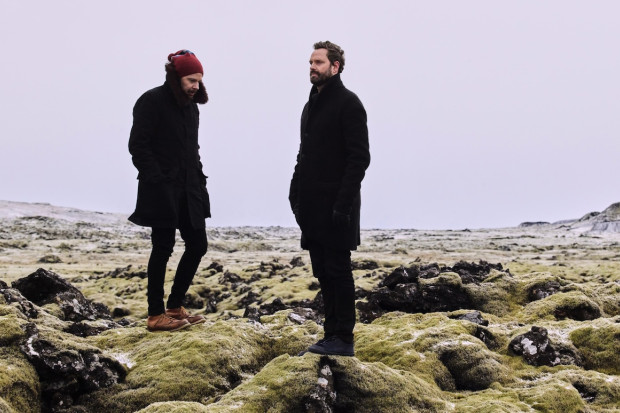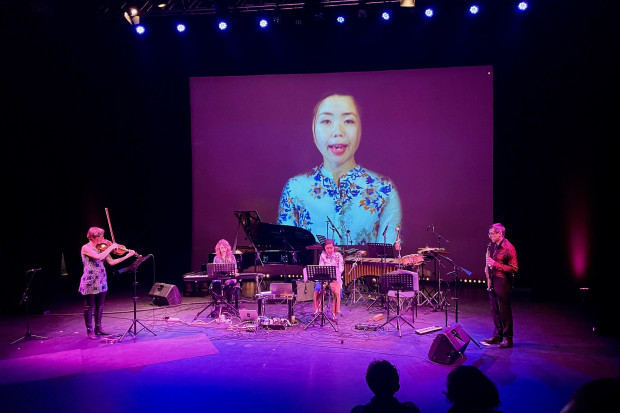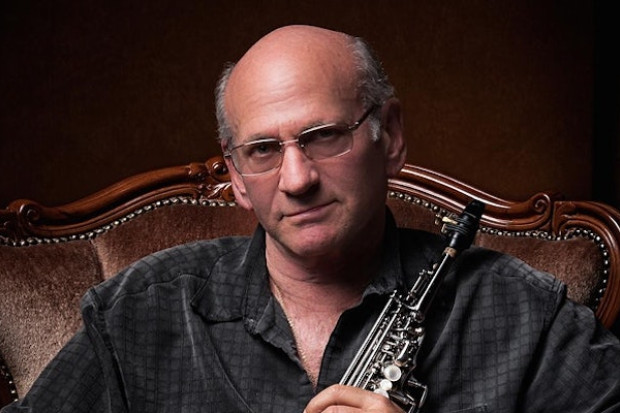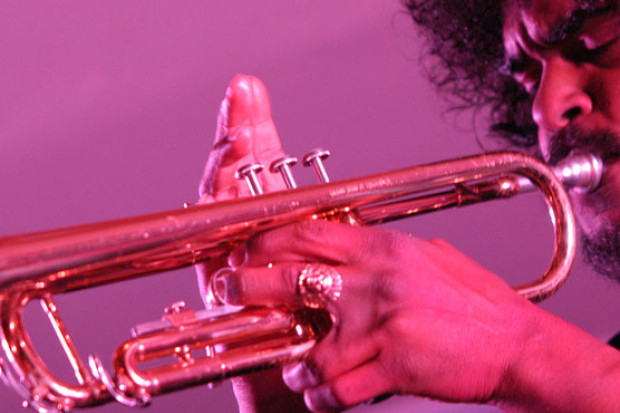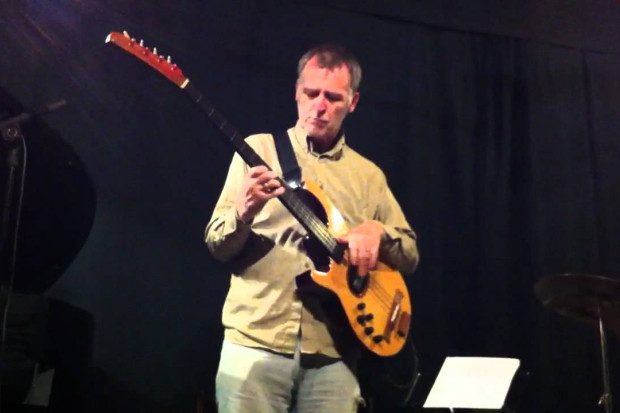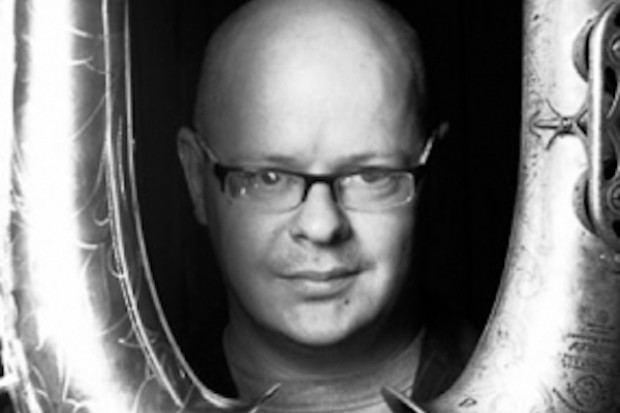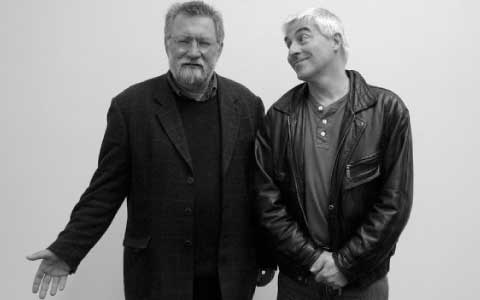
Evan Parker and Barry Guy
Sounds Left Behind
In the last issue of The Journal of Music, Ronan Guilfoyle (‘Are We Jazz Musicians Anymore?’) mused over the fact that so many of his students – who are pursuing a jazz performance degree – hesitate to describe themselves as jazz musicians. Why are so many students and practitioners reluctant to identify with the term? Is it a matter of confused terminology? Guilfoyle helpfully proposes a definition: ‘Jazz,’ he says, ‘is a largely improvised music, in which all members of the group improvise, and which is informed by the Afro-American rhythmic tradition.’ This allows him to separate jazz from most rock music and to include various European forms of jazz. One of these might be called the ECM school, ECM being a label that has become identified with a subtle and sophisticated (or, for its critics, blandly tasteful) European off-shoot of jazz. Jan Garbarek is the most widely known figure here, though he has been replaced as an active figure by other younger (often Nordic) musicians like Jon Balke, Bobo Stenson or Arve Henriksen. Guilfoyle also throws his net wide enough to include European jazz where it intersects with other national and ethnic musical cultures. This tendency is particularly strong in Italy. Dublin-based Francesco Turrisi and his various groups (Mediterranean rather than narrowly Italian in flavour) could be taken as representative. Rather than being precious about definitions, musicians of these schools should, as Guilfoyle suggests, be happy to describe themselves as jazz musicians.
As one of the possible reasons for reduced identification with the term jazz, Guilfoyle also mentions the jazz/free jazz schism of the 1960s. This is territory that shows just how difficult and contentious matters of definition can become, and how the internal evolution of particular sub-categories can force serious redefinition. Here, a look at the British scene might be illuminating, as it was in Britain that many of the jazz/free jazz/not-jazz wars have been articulated and fought. If we are talking about breaking away from swing- and blues-inflected musical improvisation, there is no clearer example than the British one. The late 60s and 70s saw a dramatic upsurge in activity in Britain, as people like the percussionist John Stevens, saxophonist Evan Parker, guitarist Derek Bailey and others largely discarded tonality, chord-based improvisation and African-American rhythms. In the accelerated history of jazz, it had been possible for the poet Philip Larkin – a grumpily entertaining conservative critic where both music and poetry were concerned – to see Charlie Parker as the jazz equivalent of such loathsome modernistic figures as Ezra Pound and Pablo Picasso. In hindsight, the real modernist break can be identified in the music of Ornette Coleman, late John Coltrane and others in the 1960s. (However, there are few total breaks in art: Boulez or Berio can be read both historically within the history of their musical cultures and as part of an international avant-garde. Likewise, though shaking the musical foundations of jazz, some seemingly revolutionary Americans retain an expressionistic quality that can be traced back to New Orleans.)
As the first-generation British avant-garde (another increasingly dubious term) created their own distinctive musical worlds, they felt that they were throwing off American musical hegemony. In the process, of course, they moved so far from mainstream musical idiom as to more or less condemn themselves to a life on the musical margins – even if they had intellectual support for their positions and a loyal following. Many players of that generation have played in the most varied contexts and combinations: some arcane, some joyous and some tedious, too, no doubt. Is the line between their music and jazz a clearly defined one? Some would say so. For some, to hear the sax/bass/drums combination of the Evan Parker/Barry Guy/Paul Lytton trio in full flow is to experience energy and moment-to-moment unpredictability and responsivity reminiscent of the great jazz formations of previous generations. For others, limits must be set to the elasticity of the concept of jazz. As for the players themselves, though emphatic about the separate direction they have taken, their admiration for the greats of earlier generations is patent. There is a wealth of material concerning European and American developments on the website of the American player and band leader Ken Vandermark. It includes a lengthy and loving assessment of Coltrane’s music by Evan Parker as well as a reported comment by Paul Lytton evoking a sense of painful separation from the American jazz tradition.
Division caused by adherence to a particular musical ethos or a desire for creative autonomy is understandable and can be debated openly, but other more sensitive issues can also arise. One of these is the question of race. In an earlier issue of the Journal of Music, I looked at AACM, the black Chicago-centred avant-garde movement. Despite their relative musical compatibility, there has been very little interaction between today’s AACM players on one side of the city and the mostly white players who associate with Ken Vandermark on the other. The division is at least as much sociological as musical, being rooted in the near-apartheid that has prevailed in the city. Today, for whatever reason, cross-Chicago initiatives seem to be rare, but Vandermark, an open-minded and generous figure, can play regularly with non-AACM black avant-garde players like Joe McPhee (whose early recordings were explicitly part of the black liberation movement) and other black American players, as well as with European free-jazz veterans like Peter Brotzmann, Barry Guy and Evan Parker. If the story within one city resists tidy definition, it is hardly surprising that inter-continental tensions will do likewise. While Europeans want to be seen as serious artists in their own right and not condescended to by Americans, regardless of race, some black American players – recalling the long history of white commercial success built on what they see as their distinctive music – look at the European scene, whether mainstream or avant-garde, as a comfortable satellite of white America. And, conversely, there have been a few dubiously-phrased assertions of European autonomy.
For the post-Parker generation of British players, the African-American dimension becomes almost irrelevant. Instead, Parker, Bailey and their fellows have become the inherited tradition, with John Butcher perhaps as a transitional figure. Many younger players, such as Mark Wastell or Rhodri and Angharad Davies, have tended to discard any remaining swing and blues elements as well as the high-energy approach mentioned above in favour of highly intellectualised exploration or a kind of sonic pointillism. Among them, not surprisingly, the improvisation group AMM are the favoured forefathers, a group whose personnel has included, at various times, Cornelius Cardew, Christian Wolff and John Tilbury, all of them at least as well known in other musical domains. AMM has always held to an impersonal, process-centred form of creation. Here, the British join a whole network of musicians across Europe whose style of low-key, disciplined improvisation might have more affinity with contemporary composition (post-Feldman, post-Tenney) than with jazz. In Ireland, this world can be sampled in the annual i-and-e festival. There, earlier this year, not untypically, the tuba player Robin Hayward, who is mentioned in a recent Journal of Music review of Larry Polansky music, performed an austere solo set that pulled reluctant sounds out of silence.
What, then, are we to make of another austere performer at that festival: Seymour Wright? His set seemed to foreground the thinking that goes into improvisation rather than the sounds themselves. As he stared at the pieces of the dismantled alto sax, we felt, not hesitation or uncertainty, but the weight of the available choices and the physical reality of the means of music-making. Wright went on to produce sounds, but always at a thoughtful remove. Even the angles formed by head, elbows and instrument seemed to demonstate deliberation and deliberateness, and there was a touch of Rodin’s statue of the Thinker to the final gesture. It takes self-confidence (and a collaborative audience) to bring off this specialised kind of performance. It was a theatrical as much as a musical experience, but late Beckett rather than Shakespeare. I’m still not sure what I experienced, but I think it was more a performance about music than a performance of music. Perhaps inverting Whitney Balliett’s mini-definition of jazz, this was an invitation, not to the sound of surprise, but to the surprise of sound itself.
Published on 1 October 2009
Barra Ó Séaghdha is a writer on cultural politics, literature and music.










